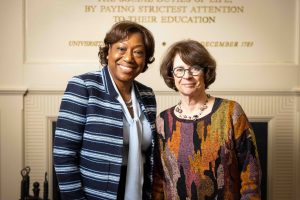Reckford Lecture Highlights Picasso’s Works and Influences
April 22, 2024 | Kristen Chavez
 In February, the Institute for the Arts and Humanities presented the Mary Stevens Reckford Memorial Lecture in European Studies, with keynote speaker and art historian Christine Poggi.
In February, the Institute for the Arts and Humanities presented the Mary Stevens Reckford Memorial Lecture in European Studies, with keynote speaker and art historian Christine Poggi.
Poggi, a professor of fine arts and the Judy and Michael Steinhardt Director of New York University’s Institute of Fine Arts, explored Picasso’s use of wood in his works from 1906-08 and 1912-14. She delivered her lecture, “From Primal Matter to Surrogate Veneer: Wood and Faux Bois in Picasso’s Cubism,” to a full University Room in Hyde Hall.
Poggi’s research focuses on European avant-garde artists, collage and constructed sculpture, the rise of abstract art, and how art intersects with new and developing forms of labor, technology, and media.
In her lecture, Poggi pointed to several works by Picasso and Georges Braque, both of whom devised the collage form in their art. Both artists utilized different techniques to comment on emerging technologies in collage, intentionally recreating wood elements in their works. As she traced Picasso’s use of wood in sculpture and in paint, Poggi also noted how his scenes in the forest demonstrated a return to pre-civilization and commented on sexuality.
IAH Director Patricia Parker highlighted Poggi’s deft ability to share her expertise. To illustrate, she quoted colleague and art professor Daniel Sherman, who noted that Poggi’s “work shows a great sensitivity to the relationship between art and language — art as a language of its own, but also… its connection to other kinds of language.”
The Reckford Lecture was co-sponsored by the Center for European Studies. Leading up to the lecture, CES hosted a panel discussion, “(Anti-)Fascism and Avant Garde Movements.” Wake Forest University’s John Curley joined Carolina faculty Richard Langston and Daniel Sherman to provide an introduction to avant-garde art movements and explained the artists’ positions regarding the rising threat of fascism.
CES director Priscilla Layne invited students from her class on the history of graphic medicine. “There’s a lot we can learn today from historical avant-garde movements and how they navigated the tumultuous politics of their time,” said Layne, a professor in the German and Slavic Languages and Literatures department.
“While some movements, like futurism, aligned themselves with the emerging fascist tendencies in society, others like dada or surrealism, sought to challenge binary thinking, raising questions like ‘What counts as art?’, ‘What is high vs low culture’ and ‘How can art help us think our way out of repressive categories?’ These are important discourses for us to consider in a current political climate where there are many ongoing debates about art and censorship that affect education,” Layne added.
The Mary Stevens Reckford Memorial Lecture in European Studies was established in 1990 by classics professor Kenneth J. Reckford to honor his late wife, Mary Stevens Reckford. The lecture is designed to provide a public audience with “pleasure, instruction, an interdisciplinary approach and a sense of shared humanity.”
View the Reckford Lecture in the video below. Turn on captions by clicking on the ‘CC’ button on the lower right.
Categories: Featured News Content, News

